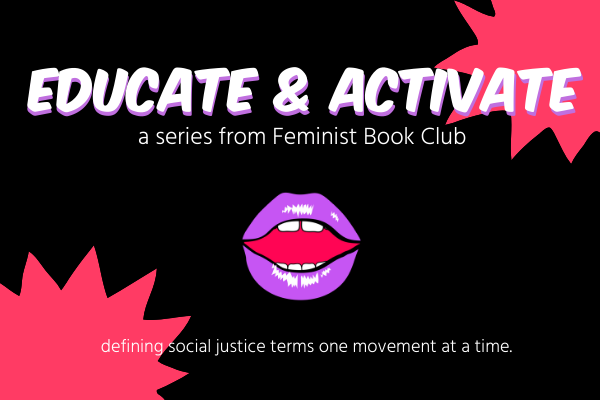Introduction:
Feminist Book Club blog contributors are working together to create posts as an “Educate & Activate” series. We will define a term or movement, provide historical context, and give you additional resources to learn more. We believe that an educated populace can be better activists, accomplices and co-conspirators. It is important to note that these are meant to be brief descriptions and not inclusive or exhaustive of all resources. We urge you to continue being curious, and continue learning more.
Definition
What is ethnocide? Ethnocide is the deliberate and systematic destruction of a particular ethnic culture.
First usage
Ethnocide was first used by Raphael Lemkin in 1944 in his book, Axis Rule in Occupied Europe, where genocide appeared for the first time. Ethnocide appeared in the footnote as a substitute for genocide. Lemkin believed that ethnocide and genocide “would be interchangeable because the targets for this previously undefined murder (cide) and terror were both a people (genos) with a specific culture, nation, and ethnicity (ethnos).”
Historical Context
For Lemkin genocide had two phases: “one, destruction of the national pattern of the oppressed group; the other, the imposition of the national pattern of the oppressor.” According to Lemkin, if both of these phases occur, then genocide has occurred, even if “every member of the targeted group has survived the process in a physical sense.”
The United Nations (UN) Secretariat created the original draft of the 1948 Convention on the Prevention and Punishment of the Crime of Genocide, built on the work of Lemkin. It included definitions of different types of genocide: physical, biological, and cultural. Cultural genocide was defined as:
“Destroying the specific characteristics of the group by:
a) forcible transfer of children to another human group; or
b) forced and systematic exile of individuals representing the culture of a group; or
c) prohibition of the use of the national language even in private intercourse; or
d) systematic destruction of books printed in the national language or of religious works or prohibition of new publications; or
e) systematic destruction of historical or religious monuments or their diversion to alien uses, destruction or dispersion of documents and objects of historical, artistic, or religious value and of objects used in religious worship.”
Unfortunately, there are numerous examples of ethnocide in history. In war, the winning group has removed cultural property belonging to the defeated group and destroyed their heritage, such as the destruction of Carthage in 146 BCE by the Romans. Cultural heritage has been “a rallying point for the self-confidence, aggressiveness, and revival of enemy communities.” Consequently, destroying cultural heritage was a “part of successful warfare and domination.” Examples of these include: Burmese forces destroying Khmer sites in the thirteenth century, Spanish invaders destroying Inca and Aztec cultures, Japan destroying Korean and Chinese culture, Nazi Germany annihilating Jewish culture, and Chinese authorities destroying Tibetan culture since 1951.
Some European anthropoids, including Robert Jaulin and Pierre Clastres, provided a new interpretation of ethnocide in the 1970s “focused on the intentional destruction of culture while keeping the people. The culture dies, but the people remain,” and has been the new understanding of ethnocide. It was used to describe “the impact of colonization and forced assimilation on indigenous peoples around the world.”
The Dignity Rights Initiative and its collaborator, The Sustainable Culture Lab, expand this definition of ethnocide to “include the transatlantic slave trade, and the entrenched divisions and exploitative norms that have tragically been foundational to the societies of the Americas.” The former intentionally destroyed the culture of African people but kept the people.
Lastly, ethnocide was also a feature of Indigenous-White American relationships in the US, specifically, the prohibition of Indigenous religion and language and assimilation. The US government forced assimilation on the Indigenous population in the 1880s, where “Assimilation was a deliberate program to strip Indians of their religions, cultures, languages, ways of life, and identities as native people and turn them into white farmers with Christian values.”
Resources for Further Education (this is by no means an exhaustive list):
An Indigenous Peoples’ History of the United States by Roxanne Dunbar-Ortiz
(Editor’s Note: Roxanne Dunbar-Ortiz was asked by the Cherokee Nation to stop identifying publicly with being Cherokee and she has agreed to do so, previously she identified as Cheyenne without proof. We at FBC recommend the book because it is an interesting perspective on the history of the United States, but acknowledge and understand that the author is Rachel Dolezal levels of problematic.)
Clearing the Plains: Disease, Politics of Starvation, and the Loss of Aboriginal Life by James W. Daschuk
The Outside Circle by Patti LaBoucane-Benson
Canada In Decay: Mass Immigration, Diversity, and the Ethnocide of Euro-Canadians by Ricardo Duchesne
A Bag of Marbles: The Graphic Novel by Joseph Joffo Kris
Auschwitz: A New History by Laurence Rees
The Night Trilogy by Elie Wiesel
Big Brains podcast episode, Correcting History: Native Americans Tell Their Own Stories
All My Relations podcast that discusses “what it means to be Indigenous in 2019, from the POV [point of view] of two American Indigenous feminists”
History of Indigenous America podcast
American Indian records in the National Archives
First Person Podcast Series which features excerpts from 48 interviews with Holocaust survivors
The “Indian Problem” video
Holocaust Documentary: We Shall Not Die Now


